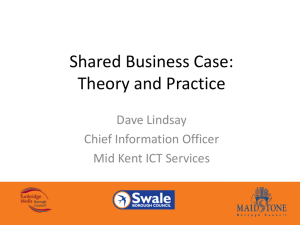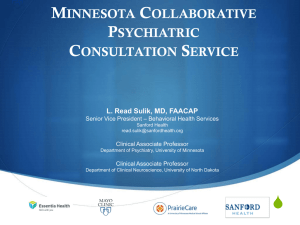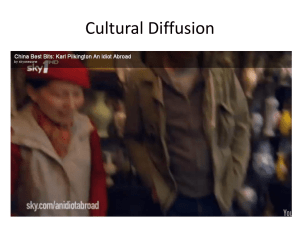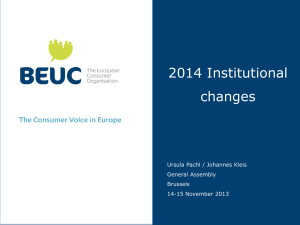A Study of Multiple Social Media Use in the European
advertisement
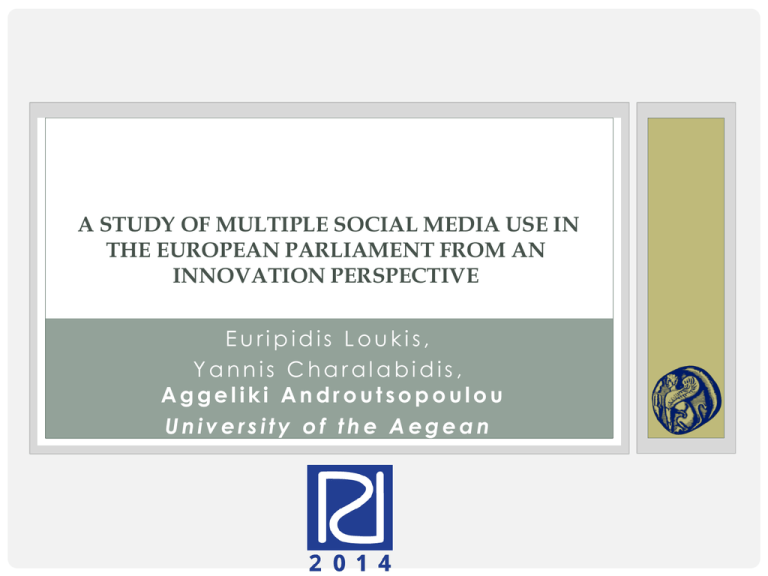
A STUDY OF MULTIPLE SOCIAL MEDIA USE IN THE EUROPEAN PARLIAMENT FROM AN INNOVATION PERSPECTIVE Euripidis Loukis, Yannis Charalabidis, Aggeliki Androutsopoulou University of the Aegean STRUCTURE Introduction Background Social Media in Government Diffusion of Innovation Theory Pilot Applications Research Methodology Results Conclusions Future Research INTRODUCTION • Utilization of social media by government agencies as a new channel of interaction with citizens in public policies lifecycle Innovation for governments = Need for (non-technological) evaluation • Analysis of advanced social media exploitation in government from innovation perspective • To what extend they have the fundamental preconditions for a wider diffusion in government • Characteristics that favor / hinder diffusion? Required improvements? INTRODUCTION • Analysis of an advanced form of multiple social media exploitation in government • Based on Diffusion of Innovation Theory of Rogers • Automated use of multiple social media from a central ICT platform for the conduction of consultation campaigns on policy-related topics • Centrally controlled and coordinated publishing of relevant content in different SM • Automated retrieval of users interactions • Advanced processing of citizens’ interactions • calculation of various analytics • text mining • future projections through simulation • Technological Infrastructure, using APIs of targeted SM RESEARCH CONTRIBUTION • Development of effective methods and practices of social media exploitation in government • Enhancing and supporting internal functions and interaction with society • Understanding better their impact and value, and also the challenges they pose and their limitations BACKROUND SOCIAL MEDIA IN GOVERNMENT • SM support, enhance transform critical government functions: i. ii. iii. iv. increase citizens’ participation and engagement promote transparency and accountability proceed to public services co-production with citizens exploit citizens’ knowledge and talent to develop innovative solutions to complex societal problems • New models and paradigms in the public sector: i. ii. iii. social media-based citizen engagement models social media-based data generation and sharing models social-media based collaborative government models BACKROUND SOCIAL MEDIA IN GOVERNMENT • Application of the ‘crowdsourcing’ ideas for public policy making • Adoption of Open Innovation Ideas • Design of highly innovative public policies BACKROUND DIFFUSION OF INNOVATION THEORY Rogers Diffusion of Innovation Theory (2003) Relative Advantage Observability Compatibility Adoption of innovation Trialability Complexity PILOT APPLICATIONS • Three pilot applications of the approach were organised • In cooperation with three Greek Members of the European Parliament (MEPs) • using their existing personal accounts in three different social media platforms (Facebook, Twitter, Blogger) • various interested social actors involved • Public consultations on three social problems: • underrepresentation of women executives in the higher management of enterprises • the socio-economic crisis in the societies of the Southern European countries • the exploitation of renewable energy sources, especially wind power, for improving capacity in energy production. PUBLIC CONSULTATIONS ORGANIZATION Presentation of the concept to several MEPs Presentation of the ICT platform, selection of topics - problems with interested MEPs and Assistants Community Building (established social networks and invitations to additional groups) Preparation of messages and multimedia content Launch of consultation (publishing content) Operation of consultation (monitoring 15 days) Conclusions and analysis, discussions with MEPs teams Dissemination Activities RESEARCH METHODOLOGY • Data Collection • Social Media Metrics • level of reach (Google Analytics, SM visitors) • level of engagement (active SM reactions) • Textual Input Analysis • opinion mining analysis (topics and sentiments) • In detail examination and classification • Focus group discussions • with the three MEPs’ teams involved in consultations • presentation of above results • semi–structured on the diffusion of innovation theory MAIN FOCUS GROUP QUESTIONS To what extent the proposed approach: • is a better way for consultations with citizens on various public policies than the other existing ‘physical’ (i.e. through ‘physical’ meetings) or ‘electronic’ ways for this (relative advantage) ? • is compatible with the values and the policy formulation processes of government agencies (compatibility) • its practical application by government agencies policy makers does not require much effort (complexity) • it can be initially applied in small scale pilot applications by government agencies, in order to assess its capabilities, advantages and disadvantages, before proceeding to a larger scale application (trialability) • is an innovation highly visible to other public agencies, policy makers and the society in general, which can create positive impressions and comments (observability) RESULTS RELATIVE ADVANTAGE “transferring the consultation outside the events we usually organise” • Much wider reach and participation of citizens in comparison with the traditional methods (physical events and meetings) with reasonable effort and cost • Especially useful for involving younger target groups in such debates, which seems difficult to be achieved currently with the traditional consultation methods • Relative disadvantage: Risk of consultations among like-minded individuals, leading to reduced diversity of opinions and perspective • exploit not only SM accounts and networks of MEPs, to access a wide range of communities and diverse actors • combine with the outcomes of other traditional consultations usually conducted by the EP on the same topic, and also with experts’ proposals RESULTS COMPATIBILITY • Compatible with: • the objectives and practices of the EP, which already organizes consultation processes when preparing proposals, directives and programmes • the main findings of the first pilot consultation were included in the report on this draft directive to be discussed in the EP • the mentality and skills of most young MEP Assistants • Less compatible with the older ones RESULTS COMPLEXITY • Low complexity • Some initial effort required for the familiarization with the concept and the supporting central platform. • For more complex consultations (organized by several social actors collaboratively) much more effort is required (coordination and alignment of the campaign in four countries, in different languages and timezones). RESULTS TRIALABILITY • High trialability: • the approach may be experimented in a small scale without particular problems, before proceeding to a larger scale RESULTS OBSERVABILITY • Medium to high observability and visibility • mainly by the networks of the initiator MEPs. • integrate the multiple discussions in a single digital space accessible to increase the visibility by citizens, providing a single point of reference and an overall picture CONCLUSIONS • The approach possesses to a good extent the required characteristics for wide adoption and diffusion • Strong relative advantage over traditional consultation methods • Good degree of compatibility with the objectives and practices of government agencies • Low complexity • High trialability and visibility CONCLUSIONS • Research Implications: • New direction of research on the use of social media by government from a public policy perspective • Practice Implications: • Guidance to government agencies management and elected representatives for the effective exploitation of popular social media platforms in policy making processes FURTHER RESEARCH • Social media use for supporting various stages of the policy making cycle • by government institutions of different types and levels • for different kinds of policies and social problems. • Combination with consultations based on other more structured ICT tools, such as structured forums





